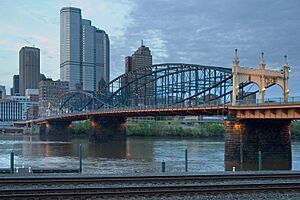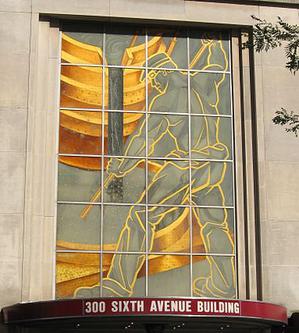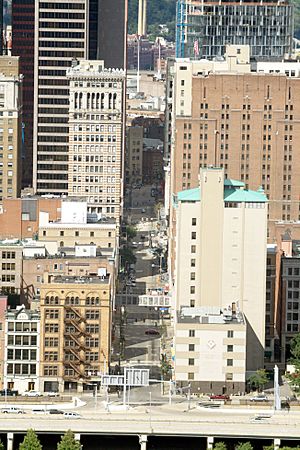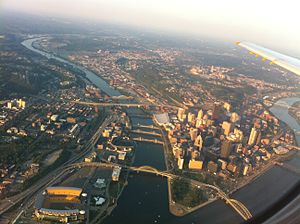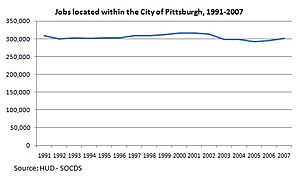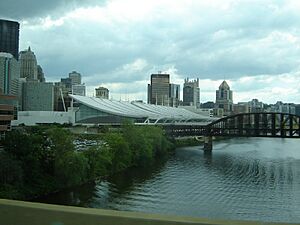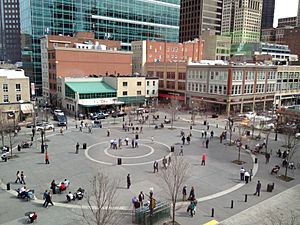Downtown Pittsburgh facts for kids
Quick facts for kids
Downtown
Central Business District; Golden Triangle
|
|
|---|---|
|
Neighborhood
|
|
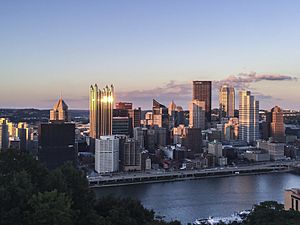
Downtown Pittsburgh as seen from Mount Washington
|
|

Location of Downtown Pittsburgh in Pittsburgh
|
|
| Country | United States |
| State | Pennsylvania |
| County | Allegheny County |
| City | Pittsburgh |
| Area | |
| • Total | 0.64 sq mi (1.7 km2) |
| Population
(2020)
|
|
| • Total | 5,477 |
| • Density | 8,560/sq mi (3,304/km2) |
Downtown Pittsburgh is the busy city center of Pittsburgh, Pennsylvania, in the United States. People often call it the Golden Triangle because it's shaped like a triangle. This area is where the Allegheny River and the Monongahela River meet to form the Ohio River. The two rivers create the triangle's edges.
Downtown Pittsburgh is home to many big companies. You'll find offices for places like PNC Bank, U.S. Steel, and PPG. It's also where famous business leaders like Andrew Carnegie and Henry J. Heinz built their companies long ago. This historic spot was once home to a French fort called Fort Duquesne.
Contents
Exploring Downtown Pittsburgh
Downtown Pittsburgh is a lively place with lots to see and do. It's known for its tall buildings, busy streets, and beautiful river views.
Where is Downtown Pittsburgh?
The main part of Downtown Pittsburgh is bordered by the Monongahela River to the south and the Allegheny River to the north. To the east, you'll find I-579, a major highway. Sometimes, people include nearby areas like the Strip District or the North Shore when talking about Downtown.
Getting Around Downtown
Getting around Downtown Pittsburgh is easy with different types of transportation.
Public Transport
Pittsburgh has a public transport system called the Port Authority. It includes a light rail subway system, known as the "T." There's also a large bus network and two inclines. Inclines are like small trains that go up steep hills. The "T" has several stations in Downtown:
- Station Square (on the South Shore)
- First Avenue (elevated)
- Steel Plaza (underground)
- Wood Street (underground)
- Gateway Center (underground)
You can also catch an Amtrak train at Pittsburgh's Union Station. These trains connect Pittsburgh to cities like New York City and Chicago. The Greyhound bus terminal is also nearby.
Major Roads
Highways like I-376 (Parkway East and West) and I-279 (Parkway North) lead into Downtown. Many people say the view of Downtown is amazing when you exit the Fort Pitt Tunnel. The city suddenly appears right in front of you!
Local Streets
Downtown streets are a bit unique. They follow two different patterns because of the two rivers. This can make directions tricky, so people often use landmarks to help you find your way.
Bridges
Pittsburgh is famous for its many bridges, earning it the nickname "The City of Bridges." Downtown alone has 10 bridges connecting it to other areas. Across the whole city, there are 446 bridges!
- Fort Pitt Bridge (carries I-376)
- Fort Duquesne Bridge (carries I-279)
- Smithfield Street Bridge (a historic bridge)
- Panhandle Bridge (for the light rail)
- Liberty Bridge
- Roberto Clemente Bridge (also known as the 6th St Bridge)
- Andy Warhol Bridge (also known as the 7th St Bridge)
- Rachel Carson Bridge (also known as the 9th St Bridge)
- Fort Wayne Railroad Bridge (for trains)
- Veterans Bridge (carries I-579)
Downtown Districts
Downtown Pittsburgh has several special areas, each with its own feel and attractions.
- The Pittsburgh Central Downtown Historic District is a historic area with many old buildings.
- Point State Park is at the very tip of the triangle where the rivers meet. It has a huge fountain and the Fort Pitt Museum. This was the site of old forts like Fort Duquesne and Fort Pitt.
- The Cultural District is full of theaters, art galleries, and concert halls. You can see shows at places like Heinz Hall and the Benedum Center.
- The Fifth & Forbes Corridor is Downtown's main shopping area. It includes the historic Market Square.
- The Grant Street area is where the city and county governments are located. It also has many of Pittsburgh's tallest skyscrapers.
- The Firstside neighborhood is a growing area with Point Park University and student housing.
Downtown's Economy
Downtown Pittsburgh is very important for the economy. It ranks high in the U.S. for the number of jobs in a city center. Many big companies have their main offices here.
Pittsburgh is known as a "headquarters city" because so many large companies are based here. Some of the major companies with headquarters in Downtown Pittsburgh include:
- Kraft Heinz
- PNC Financial Services
- PPG Industries
- WESCO International
- U.S. Steel
Other important companies like GNC and Highmark also have offices in Downtown.
Major Buildings
Downtown Pittsburgh has many impressive buildings, from historic landmarks to modern skyscrapers. Some of the most well-known include:
- Allegheny County Courthouse
- Benedum Center
- BNY Mellon Center
- David L. Lawrence Convention Center
- Heinz Hall
- PPG Place
- US Steel Tower
- Union Trust Building
Parks and Plazas
Downtown is home to many green spaces and public squares where people can relax and gather:
- Point State Park (at the tip of the Golden Triangle)
- Mellon Square
- Market Square
- Mellon Green
- Plaza at PPG Place
- US Steel Tower Plaza
- Allegheny Riverfront Park
Educational Facilities
While other parts of Pittsburgh are known for education, Downtown also has several schools and colleges:
- Point Park University
- Le Cordon Bleu Institute of Culinary Arts
- Robert Morris University's Downtown branch
- Pittsburgh Creative and Performing Arts 6–12
- City Charter High School
Where People Live
Downtown Pittsburgh has many places to live, including apartments and condos. Some buildings, like Gateway Towers, have been around since the 1960s, while others are brand new. There are over 5,000 homes in the greater Downtown area.
Surrounding Neighborhoods
Downtown Pittsburgh is surrounded by other interesting neighborhoods:
- The Bluff/Uptown
- North Shore (across the Allegheny River)
- South Shore (across the Monongahela River)
- Strip District


